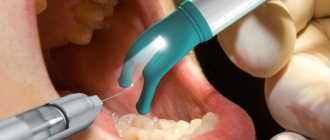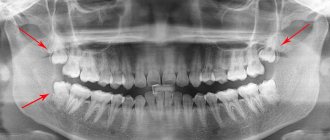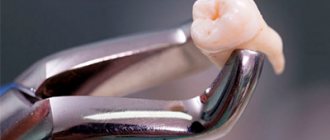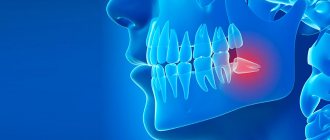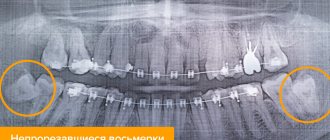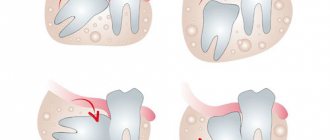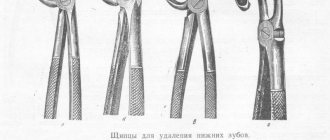What types of pain relief are used during tooth extraction?
A classic example of an archaic tooth extraction without any anesthesia is an episode from Chekhov’s story “Surgery.” In modern dentistry, such outright torture does not happen, and tooth extraction without anesthesia is not carried out under any circumstances. If it is necessary to remove 1 - 2 teeth in one visit, the operation is carried out mainly under local anesthesia. However, there are indications for tooth extraction under general anesthesia.
In medicine, the term “general anesthesia” means a state of inhibition of the central nervous system with a temporary immersion of the patient into sleep of varying degrees of depth and loss of pain sensitivity. This reaction of the body is artificially induced using safe anesthetic medications, and it lasts from 30 minutes to 3 hours, depending on the required volume of surgical intervention. For example, removing 4 wisdom teeth under general anesthesia will require a significant amount of time.
Indications for wisdom teeth removal
If the figure eight has erupted exactly in a row, grows with the crown up, does not put pressure on the teeth in front and is not affected by caries, then it is considered healthy. If the unit is not damaged, does not cause pain, and the enamel damage is at the staining stage, then Implantmaster specialists will try to save it.
Removal of a wisdom tooth by a dental surgeon will be required if:
- non-anatomical location, dentition disorder, injury to soft tissues and oral mucosa;
- development of inflammation (gingival hood, pulp, bone tissue near the root apex, periosteum);
- complete or partial retention – failure to penetrate through the mucous and gingival tissue;
- extensive carious lesion, not properly treated, damaging the unit in front;
- exerting a compressive effect on the nerve;
- the presence of a cyst around or on the roots.
These processes are accompanied by painful discomfort in the mouth, which disappears after the removal of the wisdom tooth.
Advantages of tooth extraction under general anesthesia
- Anesthesia slows down the body's reactions, due to which the pain is completely relieved. Therefore, all the dentist’s procedures for removing teeth will be completely painless for you.
- Many sensitive patients put off visiting a surgeon until dangerous complications develop simply because they are afraid of the mere sight of surgical instruments. If teeth are removed under general anesthesia, you will not see how the process will occur, but will only wake up when it is over.
- Even for a psychologically stable person, tooth extraction is a stressful situation that negatively affects the body. For example, patients often experience increased blood pressure during this procedure. However, if the operation is performed under general anesthesia, your nerves will not be damaged.
- While the anesthesia is in effect, the dentist will remove the necessary teeth and perform the necessary manipulations, which could take several visits. He will perform all actions carefully and efficiently, which will reduce the risk of complications.
Interesting fact!
According to data from various media sources, at least 2% of adults and 6 - 8% of children, for various reasons, do not have the opportunity to undergo routine tooth extraction using local anesthesia.
Atraumatic removal of wisdom teeth using ultrasound
The possibility of performing atraumatic wisdom tooth removal in the clinic is of the most frequent interest, judging by patient reviews. Atraumatic extraction of the unit is performed after a complete assessment of the CBCT image and clinical situation, as well as discussion of the procedure with the patient. The tooth is divided into several parts if there are bends and slopes of several roots. And with the help of elevators and specialized tools, careful dislocation is carried out.
You should not worry about passing a small blood clot after surgery. The extraction is fully controlled by the doctor; after extraction, the gums are tightened and sutured with specialized suture material. Afterwards the standard rehabilitation scheme comes into effect. The only important aspect is the possible development of edema after the removal of a wisdom tooth.
Atraumatic tooth extraction is more preferable. This way, the gums and surrounding mucosa are less affected and damaged. Regeneration of the wound surface and restoration of the body occurs as comfortably and quickly as possible.
Types of anesthesia for tooth extraction and methods of its behavior
Based on the depth of anesthesia, anesthesia is divided into the following types:
- surface;
- easy;
- full;
- super deep.
For dental treatment under anesthesia, only superficial and light anesthesia is used in dentistry. While the last two types are used for complex operations, for example, for maxillofacial injuries.
Anesthesia is carried out in two main ways:
- inhalation - you inhale sprayed particles of the drug through a special mask;
- intravenously - using a regular injection.
High-quality anesthetic drugs promote restful drug-induced sleep and recovery from it without any complications. Modern anesthetic medications are highly safe and suitable even for patients with allergies. They do not cause side effects or addiction and are easily eliminated from the body.
Removal of wisdom teeth during pregnancy and lactating women
Is it possible to have wisdom teeth removed during pregnancy? For pregnant and lactating women, extraction of eights can be performed only when the unit is exacerbated or if conservative treatment is impossible. As planned, such manipulations should wait until breastfeeding is complete.
There are no technical features for extracting figure eights from women who are pregnant and breastfeeding. We strive to provide gentle, atraumatic removal with comfort for everyone. However, if emergency surgery is required to extract the third molar (the only way out), we must check all our manipulations with the treating gynecologist.
After discussion with an obstetrician-gynecologist, anesthetics with a minimal concentration of adrenaline are generally used. Thus, in the third trimester, premature labor will not be provoked, and in the first trimester there will be no threat of miscarriage.
Indications and contraindications
The use of anesthesia in each specific case must have serious medical reasons, so it is used infrequently. In addition, the cost of tooth extraction under general anesthesia is quite high. If you are simply afraid of surgery, but you only need to remove one front tooth, then in this case it is advisable to use light sedatives and carry out tooth extraction under local anesthesia. If the surgeon’s task is much more complex and the volume of work is large, then general anesthesia is appropriate.
Indications
The following main indications exist for the use of general anesthesia during tooth extraction:
- allergy to local anesthetics;
- panic fear of treatment;
- increased blood pressure (hypertension) due to stress;
- a gag reflex in the patient, which prevents the doctor from performing the operation;
- large volume of manipulations;
- inability of a patient with disabilities to sit in the dental chair.
Contraindications
Speaking about contraindications to tooth extraction under general anesthesia, you should be guided by the list of factors presented below that may cause refusal of this procedure:
- exacerbation of chronic pathologies;
- diabetes mellitus in the stage of decompensation;
- acute heart failure;
- period up to six months after myocardial infarction;
- heart defects;
- infectious diseases;
- anemia;
- epilepsy;
- pathologies of the respiratory system.
Removal of impacted and dystopic wisdom teeth
An impacted wisdom tooth is the third unerupted molar located in the jawbone, under the gum. Removing an impacted wisdom tooth is a technologically difficult surgical intervention; a small number of specialists decide to carry out such manipulations.
Specialists from our innovative dentistry perform atraumatic removal of impacted wisdom teeth using ultrasound at Implantmaster in Moscow. The experience of surgical dentists allows us to perform surgical interventions of this level.
Also, the eighth unit may not erupt due to dystopia. The second molar in front, the “seven,” is in the way. The dystopic unit rests on the seven, destroying it; this is possible due to the tilt of the unit. Due to the lack of space and location at the angle of the jawbone, there is no way to properly cut through and take its place. The dystopic figure eight, erupting non-anatomically, may occupy an atypical location in the jaw bone. An unerupted unit causes harm and discomfort to the gingival mucosa. Our specialists perform the removal of such wisdom teeth using an atraumatic technique and at a reasonable price in Moscow.
Very often, such units move adjacent teeth in a row and bend the jaws. It is very difficult or impossible to treat them at all. In such clinical situations, a dystopic wisdom tooth is removed. The result of dystopia can be chronic injury to the cheek due to biting. Therefore, it is better not to postpone the removal of a traumatically located wisdom tooth for a long time, but to contact the Implantmaster specialists in Moscow. With such a complex surgical intervention, you should follow all the doctor’s recommendations, as well as prescriptions for taking antibiotics after wisdom tooth removal.
When is tooth extraction required under anesthesia?
Complex tooth root removal
The lateral (chewing) teeth have a complex root system. Sometimes it takes quite a long time to extract them. Removing a tooth root under anesthesia allows the surgeon to carry out a large amount of work during one patient visit.
Removal of impacted wisdom tooth
One of the most difficult operations is the removal of a wisdom tooth under general anesthesia. The roots of “eights” are often irregular, intertwined with each other, and go under the adjacent tooth. Resection of unerupted (impacted) wisdom teeth is especially difficult. They have to be removed for a long time and carefully through incisions in the gums. That is why 8 teeth are removed under general anesthesia.
Removal of several molars
When it is necessary to remove several molars during one visit to the dentist, it is also advisable to use general anesthesia. Often, the doctor performs additional manipulations of gum plastic surgery with bone grafting if subsequent installation of implants is planned.
What are wisdom teeth?
Wisdom teeth, 3rd molars, eights are the units that erupt at the extremes in the row of the upper and lower jaws. Concern associated with them appears from the age of 18, when the initial growth and development of eights is activated. They entail a fair amount of problems. The most common and only correct solution is the removal of wisdom teeth.
Third molars cause many problems for everyone if careful attention is not paid to the care and cleaning of these units. The most common problem occurs due to lack of space in the dentition and jawbone. They cannot erupt freely - they remain in the bone or are partially erupted, they can stand in a row, or they can be directed with the crown part into the cheek or towards the tongue. All these problems are possible on both jaws.
In the upper jaw, the danger of occurrence lies in the possible growth of third molars into the maxillary sinus completely or with curved roots to support its bottom. On the lower jaw, figure eights put pressure on neighboring teeth. By moving the units in front, crowding and malocclusion are formed. There is a change in the healthy appearance of the smile. Compressed units need regular prof. cleaning, also to prevent the formation of carious lesions.
Working with eights has its own difficulties: difficult to reach location, especially when developing into the cheek; number and shape of root canals, complicating their therapeutic treatment. It is necessary to monitor the development of the rudiments of these units, and also immediately contact a specialist if any unpleasant sensations occur in the area of these teeth. And then, timely removal of wisdom teeth will avoid the unpleasant consequences of the development of these units.
Stages of tooth extraction under general anesthesia
Preparation
Questions about the choice of anesthetic and the method of its administration are resolved individually for each patient. To do this, the anesthesiologist will collect an anamnesis, inquire about the patient’s chronic diseases and refer him to diagnostic procedures (usually a blood test and an ECG). It is also necessary to consult with a neurologist, therapist and otolaryngologist in order to identify contraindications to the use of general anesthesia.
Operation
Literally one minute after the administration of the anesthetic by inhalation or intravenous route, the patient feels drowsy and gradually falls asleep. Within five minutes, his breathing stabilizes and his muscles relax. During a tooth extraction operation under general anesthesia, a qualified anesthesiologist is constantly with the patient, monitoring his vital signs: pulse, blood pressure, body temperature, skin tone, blood circulation and ventilation.
Coming out of anesthesia
The doctor calculates the dose of the anesthetic so that its effect ends 10 - 20 minutes after completion of all manipulations. The patient gradually wakes up, and after 60 - 90 minutes his state of health is completely stabilized. After this, he can go home, but for this he will need an accompanying person. In addition, after tooth extraction under general anesthesia, you should never drive!
When preparing for tooth extraction under anesthesia, be sure to inform your doctor about all medications you are currently taking. Six hours before surgery you should stop eating and stop smoking. Stop drinking any drinks, including plain water, at least four hours before surgery.
Features of the use of general anesthesia
In children, removal of wisdom teeth or their rudiments is carried out according to the indications and recommendations of a specialist. The decision to perform the operation is made by the parents. If your child requires dental surgery to extract eighth molars, you should make an appointment with a dental surgeon. Pre-registration at the Martinka clinic is available by phone and on the dentistry website “Free consultation”.
To eliminate all risks, it is necessary to properly prepare for surgery under general anesthesia. During the consultation, the specialist will assess the need to remove wisdom teeth and perform the treatment under general anesthesia.
If the doctor confirms that the patient requires “medicated sleep,” then preparation begins, including:
- diagnostics of the body (laboratory blood and urine tests and ECG);
- consultation with an anesthesiologist to select a drug;
- stopping food intake 6–8 hours before surgery;
- refusal of liquids 4–5 hours before the procedure.
Introduction to anesthesia can be carried out by injecting the drug into the blood, or through the respiratory tract using an inhalation mask.
How to prepare for treatment under inhalational sedation
Before implantation or dental treatment using sedation, unlike general anesthesia, no special preparation is required. The only restriction concerns food - 2-3 hours before the procedure you need to avoid consuming any foods, otherwise you may experience vomiting.
Possible contraindications are necessarily excluded. These include individual intolerance to the drug, bronchial asthma or epilepsy, acute diseases of the cardiovascular system, neuropsychiatric disorders, high intracranial pressure and acute immune disorders. The next stage is the obligatory informing of the patient about how the procedure is carried out and what sensations will arise.
What to do if the bleeding does not stop
Immediately after removing a molar, the surgeon places a tampon on the socket to stop capillary bleeding. The patient needs to clench his jaw and not remove the tampon for 20 minutes. During this time, the blood coagulates and a clot forms in the hole, protecting the fresh wound from the penetration of bacteria into it.
If the patient has high blood pressure or poor blood clotting, the tampon should be kept in place for 40-60 minutes.
When a person strictly adheres to medical recommendations, but the bleeding does not stop, he should contact a dentist for help.
Doctor's recommendations after wisdom tooth removal
The specialist gives the patient recommendations on how to care for the oral cavity and what is allowed and what is not allowed after the removal of a wisdom tooth.
General instructions:
- do not eat hard or hot food;
- do not heat the cheek area;
- refuse to visit the bathhouse and sports. hall;
- do not rinse;
- Do not disturb the hole with your tongue and fingers.
To heal the wound, it is necessary to treat the gums with antiseptic solutions two days after the intervention. The clot should not be removed from the socket to avoid bleeding. It is possible to take painkillers to comfortably overcome discomfort.
In the first days, discomfort is acceptable, but elevated temperature after wisdom tooth removal should not be present. In such situations, antibiotics are prescribed.
It is possible to relieve cheek swelling and edema by applying cold for 10 minutes at intervals of half an hour/hour.
Why are wisdom teeth needed?
Why does our body need third molars at all? In fact, these are rudiments that not all people today erupt - approximately a third of the entire population of the planet does not even have the rudiments of third molars, although a few thousand years ago absolutely all adults grew wisdom teeth. They practically do not perform the chewing function, since the rest of the healthy teeth usually cope with it.
Today, “eights” are needed only as a “backup option” in case the first and second molars fall out or are severely damaged, and also as a factor preventing the loosening of neighboring teeth. They can also serve as a support for prosthetics - but, again, in all these cases we are talking about healthy and correctly erupted “eights”. In the same case, when a person has rotten wisdom teeth in his mouth, they will not be able to perform any of the indicated functions and it is better to remove them so as not to expose the rest of the dentition to the risk of infection.


